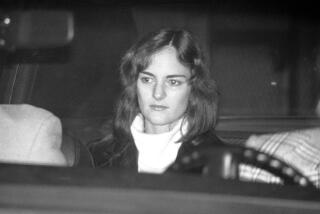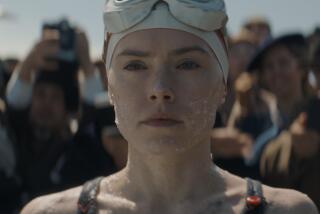That soaring spirit
- Share via
There’s something about Amelia Earhart.
More than seven decades after she disappeared without a trace in the South Pacific on her flight around the world, Earhart remains the most famous female aviator in history, a timeless heroine and inspiration to generations of women, filmmakers and fashionistas.
Flying was just the beginning. Earhart was also a fashion icon and designer with her close-cropped hair, pants and leather jackets. She was a leader in women’s rights and the peace movement. She was a president and founding member of the Ninety-Nines -- the original women’s pilot organization. She was a pioneering businesswoman -- a partner in both Transcontinental Air Transport and Ludington Airlines and a luggage designer -- a wife (she was married to publisher George Putnam) and a writer.
“She definitely has a legacy,” said Dorothy Cochrane, the curator overseeing Earhart’s fire engine red Lockheed Vega, in which she flew solo across the Atlantic in 1932 and which is now housed at the Smithsonian Institution’s National Air and Space Museum in Washington, D.C.
“I’m looking at my bulletin board here at a letter, and it’s addressed to ‘Amelia Earhart Smithsonian Institute,’ ” Cochrane noted recently with a laugh. “We are constantly getting schoolchildren writing. . . . This year, there was a flurry of activity. There is this thing called National History Day, and all of these kids decided to select Amelia Earhart. If you are going to select aviation and if you are looking for women, she’s the first one to come to mind.”
Cochrane expects Earhart’s legacy to soar even higher with the release of the family comedy “Night at the Museum: Battle of the Smithsonian,” featuring Amy Adams as Earhart, filtered through a Katharine Hepburn-Howard Hawks screwball comedy sensibility.
“Amelia,” directed by Mira Nair (“Monsoon Wedding”) and starring Oscar winner Hilary Swank, is a more serious look at her life, based on three recent biographies of the aviator. Richard Gere plays the flamboyant Putnam, who also worked to publicize his famous wife’s exploits and image.
Earhart, who turned down Putnam six times before she agreed to marry him, referred to their marriage as a “partnership” with “dual control.” The film will be released this fall.
Though Earhart has been the subject of countless books and several documentaries, very few films have been made about her.
Rosalind Russell played an Earhart-esque flier in 1943’s “Flight for Freedom”; Susan Clark tackled the role in a 1976 TV movie, “Amelia Earhart”; and Diane Keaton starred in the 1994 TNT movie “Amelia Earhart: The Final Flight.”
So why is Hollywood taking notice of Earhart now?
Nair believes it’s because Earhart “was the complete beacon of inspiration in the Depression for this country.”
“It’s sort of an incredible coincidence that we are in this slump,” she adds. “I think it’s an excellent time to remind people of the heroes that kept us afloat -- more than afloat -- in Amelia’s time.”
“I think [in the 1930s] there was such a positive attitude toward Amelia and such an embracing of her can-do enterprising spirit,” said Shawn Levy, who directed “Battle of the Smithsonian” as well as the 2006 box office hit “Night at the Museum,” both of which star Ben Stiller.
“That is very much the spirit we hope our movie has. So, the idea of channeling that affirmative energy -- that kind of self-belief -- makes her a formidable figure and for those reasons made her a formidable costar and foil to Ben Stiller.”
“When we started to research her,” says Thomas Lennon, who co-wrote both “Museum” films with Robert Ben Garand, “what was interesting about Amelia Earhart was a lot of people become famous after they have done things. She was famous when she was alive.”
Made in cooperation with the Smithsonian and partially shot there, “Battle of the Smithsonian” finds Larry (Stiller) traveling to the site after museum pieces -- including an Egyptian artifact that brings the exhibits to life at night -- at the Museum of Natural History in New York are moved to storage underneath the largest museum complex in the world, in Washington, D.C. When the evil Pharaoh Kahmunrah (Hank Azaria) comes to life thanks to the artifact, he decides to take over the world. Larry heads off to the Smithsonian to help out his friends, who are being threatened by the pharaoh. Helping Larry in his quest is Earhart, who provides needed moxie.
Adams says it was an amazing experience to play Earhart -- even a highly fictionalized version.
“What I talked to Shawn about is what we needed for the film and what elements of Amelia’s character I could bring -- it was her sense of adventure and her ability to be a leader,” said Adams. “She is part of that iconic idea of feminism. She really paved the way.”
Earhart, who was born in 1897 in Atchison, Kan., was in the 1930s “one of the very few women to make a career in aviation,” said Cochrane. “It was very difficult to be able to own and operate aircraft.
“Back then, women were part of families, but there were other women who had other ideas, and she was one of them. She wanted to be independent and fashion some career. Once she found aviation, she knew she wanted to do it. She was a role model as far as being a career woman, and even the career she selected was extraordinary.”
And she was accepted into the boys’ club of pilots, says Cochrane, because she was serious about aviation.
“If you were a woman and showed some real interest and talent and kept at it, you would be accepted,” says Cochrane.
Earhart gained national attention in 1928 when she was the first female passenger on the Fokker Friendship, which successfully flew across the Atlantic.
She made her own nonstop solo flight across the Atlantic 77 years ago this month. Earhart also accomplished the first solo transcontinental flight by a woman in 1932 and in 1935 made the first solo flight by anyone from Hawaii to the U.S. mainland.
Her disappearance -- along with navigator Fred Noonan -- on July 2, 1937, added to her mystique.
“It’s one of the great mysteries of the 20th century,” said Cochrane. “Such a famous person literally just disappearing off the face of the Earth and there is nothing left. . . .”
Official search efforts lasted until July 19, then Putnam financed a private search. By 1939, he had given up hope and declared her officially dead.
Over the years, historians and researchers have mulled over what happened -- one thought is that she and Noonan crash-landed on uninhabited Gardner Island and perished; during World War II, it was believed she may have been spying on the Japanese for President Roosevelt -- that was the theme of “Flight for Freedom” -- and another theory posits that she and Noonan were captured and later executed by the Japanese when their plane crashed on Saipan Island.
Cochrane said there are many reasons why they didn’t reach their next destination of Howland Island.
“It’s only two miles long and less than a mile wide,” she said. “She had a very good navigator. They should have been able to find it. But they also say that she had an old map, so the island was off about six miles.”
Earhart knew the risks of flying, but that never stopped her.
“She tried to keep the sky very present in her life, because she needed it like oxygen,” said Nair.
“She was incredibly stylish, but it was her passion with her occupation that created that particular style.
“She always marched to her own drum, but her life was not about herself. It was the larger good -- who she could impact.”
--
More to Read
Only good movies
Get the Indie Focus newsletter, Mark Olsen's weekly guide to the world of cinema.
You may occasionally receive promotional content from the Los Angeles Times.









